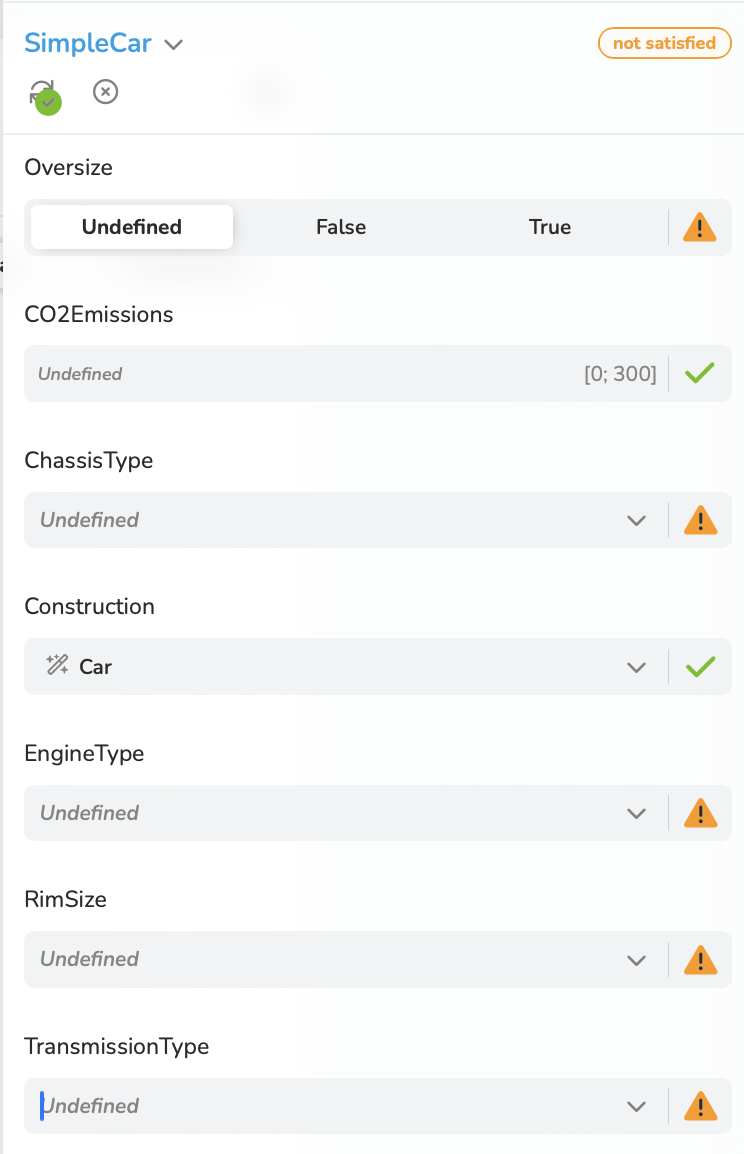5.2 Initialization of the Configuration Dialogue
From a technical point of view, a Configuration Dialogue needs to be initialized. The initialization steps are shown in Figure 5-2:

Figure 5-2: Sequence of events of the initialization workflow
The initialization starts with a POST request to create a Configuration Session for the Configuration Dialogue. There are two ways to make a Configuration Model, which generally consists of several sub models, part of a Configuration Session:
- A specific deployed model version can be obtained from a specific Channel. This is the variant for the majority of cases.
POST {{baseUrl}}/v2/session
X-API-KEY: {{engineApiKey}}
Content-Type: application/json {
"configurationModelSource": {
"type": "Channel",
"channel": "release",
"deploymentName": "SimpleAutomobileExample-SimpleCar"
}
}The source of the Configuration Model is a certain deployment channel, at the moment only release. The general form of the deploymentName is: configuration project name-configuration model name. Configuration Projects are managed in the Configuration Model Developer - see the documentation "Configuration Model Developer".
- The nested structure of the sub models can be specified as a "Package" directly in the request body.
POST {{baseUrl}}/engine/v2/session
X-API-KEY: {{engineApiKey}}
Content-Type: application/json {
"configurationModelSource": {
"type": "Package",
"configurationModelPackage": {
"root": "SimpleCar",
"configurationModels": [
{
"configurationModelId": "SimpleCar",
"sharedToConfigurationModels": [],
"attributes": {
"choiceAttributes": [
{
"attributeId": "Construction",
"lowerBound": 1,
"upperBound": 1,
"choiceValues": [
{
"choiceValueId": "Car"
},
{
"choiceValueId": "Truck"
}
]
},
{
"attributeId": "EngineType",
"lowerBound": 1,
"upperBound": 1,
"choiceValues": [
{
"choiceValueId": "Burner"
},
{
"choiceValueId": "Electric"
}
]
},
{
"attributeId": "ChassisType",
"lowerBound": 1,
"upperBound": 1,
"choiceValues": [
{
"choiceValueId": "Comfort"
},
{
"choiceValueId": "Sport"
}
]
},
{
"attributeId": "TransmissionType",
"lowerBound": 1,
"upperBound": 1,
"choiceValues": [
{
"choiceValueId": "Manual"
},
{
"choiceValueId": "Automatic"
}
]
},
{
"attributeId": "RimSize",
"lowerBound": 1,
"upperBound": 1,
"choiceValues": [
{
"choiceValueId": "16 inch"
},
{
"choiceValueId": "18 inch"
},
{
"choiceValueId": "25 inch"
},
{
"choiceValueId": "28 inch"
}
]
}
],
"numericAttributes": [
{
"attributeId": "CO2Emissions",
"isDecisionRequired": false,
"min": 0,
"max": 300,
"decimalPlaces": 0
}
],
"booleanAttributes": [
{
"attributeId": "Oversize",
"isDecisionRequired": true
}
],
"componentAttributes": []
},
"constraints": [
{
"constraintId": "ForPC-ConfiguratorConstructionIsCar",
"textualConstraint": "Construction.Car"
},
{
"constraintId": "RimExclusionsForPC",
"textualConstraint": "Construction.Car -> !(RimSize.\"25 inch\" OR RimSize.\"28 inch\")"
},
{
"constraintId": "RimSizeForSmallCO2Emissions",
"textualConstraint": "CO2Emissions <= 100 -> RimSize.\"16 inch\""
},
{
"constraintId": "OversizeExcludesElectricEngine",
"textualConstraint": "EngineType.Electric -> Oversize == false"
},
{
"constraintId": "ElectricMeansCO2EmissionsNull",
"textualConstraint": "EngineType.Electric -> CO2Emissions == 0"
}
]
}
]
}
}
}The response with the code 200 is the same in both cases of providing a Configuration Model:
{
"sessionId": "dmlhbWVkaWNpfGgzWjA3d1ByM2dNY3J5OVFmZ3MET1hUc2dHSEZzSWY=",
"timeout": {
"absolute": "2023-10-04T19:51:06.5851087+00:00",
"slidingInSeconds": 1200
}
}After a Configuration Session has been created, it must be ensured that a Configurator can display the available Attributes and their initial Value Decision States. For this purpose, the Consequences and the [Implicit Decisions] (/glossary/#implicit-decisions) resulting from the initial evaluation of the Configuration Model are retrieved with a GET requests.
The request to get the Consequences:
GET v2/session/configuration/consequence
X-SESSION-ID:
Content-Type: application/json
The response with the code 200 delivers the Choice Consequences, the Numeric Consequences, the Boolean Consequences and the Component Consequences. At the beginning of the JSON structure the Configuration Model-Satisfaction State is given ("isSatisfied": false). In the result of the initial Constraint evaluation, the Value Decision State for the value Car of the Attribute Construction is Included, while the value Truck is Excluded. The inclusion is the result of an Implicit Decisions that lead to the Attribute Satisfaction State being true. The Values of the other Attributes have the Possible Decision States Included and Excluded.
{
"isConfigurationSatisfied": false,
"choiceConsequences": [
{
"attributeId": {
"localId": "ChassisType",
"componentPath": []
},
"isSatisfied": false,
"cardinality": {
"lowerBound": 1,
"upperBound": 1
},
"values": [
{
"choiceValueId": "Comfort",
"possibleDecisionStates": [
"Included",
"Excluded"
]
},
{
"choiceValueId": "Sport",
"possibleDecisionStates": [
"Included",
"Excluded"
]
}
]
},
{
"attributeId": {
"localId": "Construction",
"componentPath": []
},
"isSatisfied": true,
"cardinality": {
"lowerBound": 1,
"upperBound": 1
},
"values": [
{
"choiceValueId": "Car",
"possibleDecisionStates": [
"Included"
]
},
{
"choiceValueId": "Truck",
"possibleDecisionStates": [
"Excluded"
]
}
]
},
{
"attributeId": {
"localId": "EngineType",
"componentPath": []
},
"isSatisfied": false,
"cardinality": {
"lowerBound": 1,
"upperBound": 1
},
"values": [
{
"choiceValueId": "Burner",
"possibleDecisionStates": [
"Included",
"Excluded"
]
},
{
"choiceValueId": "Electric",
"possibleDecisionStates": [
"Included",
"Excluded"
]
}
]
},
{
"attributeId": {
"localId": "RimSize",
"componentPath": []
},
"isSatisfied": false,
"cardinality": {
"lowerBound": 1,
"upperBound": 1
},
"values": [
{
"choiceValueId": "16 inch",
"possibleDecisionStates": [
"Included",
"Excluded"
]
},
{
"choiceValueId": "18 inch",
"possibleDecisionStates": [
"Included",
"Excluded"
]
},
{
"choiceValueId": "25 inch",
"possibleDecisionStates": [
"Excluded"
]
},
{
"choiceValueId": "28 inch",
"possibleDecisionStates": [
"Excluded"
]
}
]
},
{
"attributeId": {
"localId": "TransmissionType",
"componentPath": []
},
"isSatisfied": false,
"cardinality": {
"lowerBound": 1,
"upperBound": 1
},
"values": [
{
"choiceValueId": "Automatic",
"possibleDecisionStates": [
"Included",
"Excluded"
]
},
{
"choiceValueId": "Manual",
"possibleDecisionStates": [
"Included",
"Excluded"
]
}
]
}
],
"numericConsequences": [
{
"attributeId": {
"localId": "CO2Emissions",
"componentPath": []
},
"isSatisfied": true,
"selection": "Optional",
"range": {
"min": 0,
"max": 300
},
"decimalPlaces": 0
}
],
"booleanConsequences": [
{
"attributeId": {
"localId": "Oversize",
"componentPath": []
},
"isSatisfied": false,
"selection": "Mandatory",
"possibleDecisionStates": [
false,
true
]
}
],
"componentConsequences": []The request to query the Decisions in general, in this case only the Implicit Decisions because no explicit ones have been made yet:
GET {{baseUrl}}v2/session/configuration/decision
X-SESSION-ID: {{sessionId}}
Content-Type: application/jsonThe response with the code 200 delivers the Implicit Decisions of the different types: Choice Decisions, the Numeric Decisions, the Boolean Decisions and the Component Decisions. In the result of the initial evaluation of the Constraint true -> Construction.Car , the value Car of the Attribute Construction is included by the Configuration Engine. In this example, this is the only Implicit Decision.
{
"choiceDecisions": [
{
"attributeId": {
"localId": "Construction",
"componentPath": []
},
"values": [
{
"choiceValueId": "Car",
"state": "Included",
"kind": "Implicit"
}
]
}
],
"numericDecisions": [],
"booleanDecisions": [],
"componentDecisions": []
}An exemplary visualization of the initial Configuration State is shown in figure 5-3.

Figure 5-3: A simple UI for the visualization of the initial Configuration State